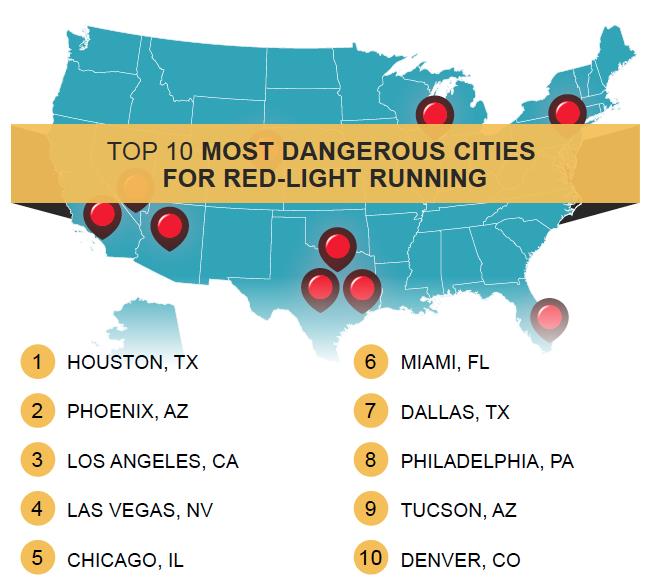Red Light Accidents
With our fast-paced lives, daily demands, social stresses and technology an arm’s reach away, it is no wonder speeding through red lights is a major issue in the United States. According to the Insurance Institute for Highway Safety Highway Loss Data Institute (“IIHS”), an average of two people die a day due to red-light running accidents in the United States. Additionally, over half of those killed are pedestrians, bicyclists and drivers and passengers in other vehicles who are hit by right light runners.
This equates to $378 million lost in costs due to red-light running deaths each month. Private insurers pay approximately 50 percent of motor vehicle crashes, while third parties such as uninvolved motorists, charities, health care providers, federal revenues and state and local municipalities pay the majority of the leftover costs.
Red Light Law
The IIHS defines a red light running occurrence as a vehicle entering an intersection any time after the signal light has turned red. The IIHS explains that red light running frequently occurs at intersections because intersections involve many moving parts, including multiple roads, cyclists, pedestrians and vehicles. Consequently, it is no surprise that red light running is the number one cause of accidents in urban areas.
Stop signs and devices are placed at crossings and intersections in which the driver is required to come to a full stop. The limit line is the painted line that indicates where the driver should stop.
In Arizona, the procedure under Arizona Revised Statute Section 28-645(A)(3) for stopping at a red light is:
3. Red indication:
(a) …vehicular traffic facing a steady red signal alone shall stop before entering the intersection and shall remain standing until an indication to proceed is shown. On receipt of a record of judgment for a violation of this subdivision or an act in another jurisdiction that if committed in this state would be a violation of this section, the department shall order the person to attend and successfully complete traffic survival school educational sessions within sixty days after the department issues the order. Notwithstanding section 28-3315, if the person fails to attend or successfully complete traffic survival school educational sessions, the department shall suspend the person’s driving privilege pursuant to section 28-3306 until the person attends and successfully completes traffic survival school educational sessions.
(b) The driver of a vehicle that is stopped in obedience to a red signal and as close as practicable at the entrance to the crosswalk on the near side of the intersection, or if there is no crosswalk, then at the entrance to the intersection, may make a right turn but shall yield the right-of-way to pedestrians and other traffic proceeding as directed by the signal. A right turn may be prohibited against a red signal at any intersection if a sign prohibiting the turn is erected at the intersection.
The Importance of Stopping on Red
Each year the National Coalition for Safer Roads joins with other organizations to raise awareness about the risks of red light running during their National Stop on Red Week. Combined, the organizations came up with a list of the top reasons it is important to stop at red lights.
The reasons include:
1. Red light running is very dangerous and against the law.
2. Red light running causes preventable fatalities. The National Highway Traffic Safety Administration has a fatality analysis reporting system, which tracks fatalities across the United States. The map indicates the top ten most dangerous cities for red light running. Cities in Arizona, California and Colorado are all included:
3. Over $230 billion is paid annually by society for automobile crashes.
4. The grief involved with red light accidents is far-reaching. One in three Americans know someone that has been injured or killed in a red light accident.
5. Vehicle crashes are the leading cause of death in children age 4 and the second leading cause of death in children ages 3 and 5-14.
Red light running causes preventable fatalities. The National Highway Traffic Safety Administration has a fatality analysis reporting system, which tracks fatalities across the United States. The map indicates the top ten most dangerous cities for red light running. Cities in Arizona, California and Colorado are all included:6. Running a red light and getting into an accident does not just affect the at-fault driver. Statistics show that nearly half of the deaths that are caused in red light accidents are cyclists, pedestrians and drivers of other vehicles.
6. In 2014, 709 people were killed and an estimated 126,000 were injured in red light running accidents.
7. Motorists in urban areas are more likely to be involved in a red light running crash than any other type of vehicle collision.
8. Studies found that drivers that are involved in red light crashes are more likely to young, male and have prior accidents or alcohol impaired convictions.
9. Estimates suggest that over 36 percent of drivers continue to run red lights even after they are educated about the statistics.
Countermeasures to Reduce Red Light Running Accidents
There are many countermeasures that may be taken to reduce the amount of red light accidents. One such measure is replacing signaled intersections with roundabouts, which statistics show to have dramatically fewer injuries. However, it is not realistic or feasible to replace all intersections with roundabouts.
Additional measures include providing adequate yellow signal time, educating drivers about the “dilemma zone” (a short period where the light turns from green to yellow), adding an all-red clearance interval (a short period after a yellow light where all lights are red), making traffic lights more visible and reminding drivers to never drive distracted. Distracted driving accounts for accidents because a driver has ran a red light, however, it also is the cause of accidents when other vehicles are stopped at red lights and get rear-ended by a distracted driver.
Another countermeasure, albeit controversial, is red light cameras. A red light camera is a device that photographs drivers as they run red lights, automatically issuing tickets to the driver. Red light cameras are usually placed at busy or dangerous intersections to encourage drivers to stop at red lights.
Some arguments in support of red light cameras include:
- Red light cameras reduce accidents. A 2011 study done by the Insurance Institute for Highway found that red light cameras lowered red light running accidents by 24 percent.
- The fines paid when a driver gets a red light camera ticket fund community needs and highway safety functions.
- Statistics have found that red light cameras save money for taxpayers and the community. A single fatal crash costs society $6.43 million dollars.
We all lead busy and important lives. However, let’s remember that the average light cycle is 120 seconds, and 120 seconds of waiting at a light will always be worth it when it may save someone’s life.



